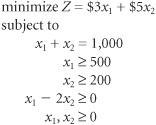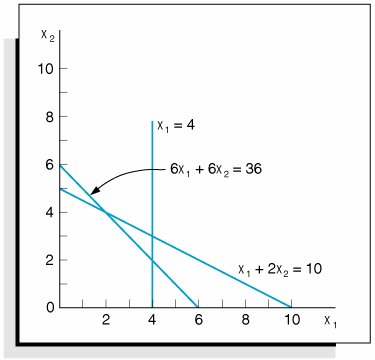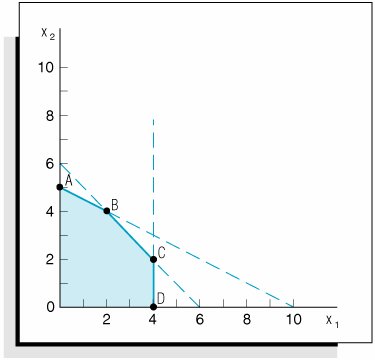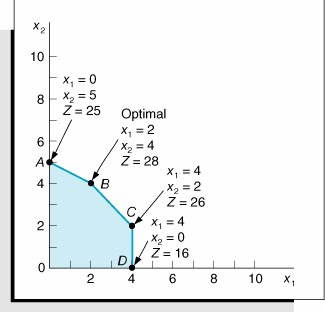Example Problem Solutions
| Ingredient | Cost/lb. |
|---|---|
| Chicken | $3 |
| Beef | $5 |
Each batch has the following recipe requirements:
-
At least 500 pounds of chicken
-
At least 200 pounds of beef
The ratio of chicken to beef must be at least 2 to 1. The company wants to know the optimal mixture of ingredients that will minimize cost. Formulate a linear programming model for this problem.
Solution
| Step 1. | Identify Decision Variables Recall that the problem should not be "swallowed whole." Identify each part of the model separately, starting with the decision variables: x 1 = lb. of chicken x 2 = lb. of beef |
| Step 2. | Formulate the Objective Function |
| Step 3. | Establish Model Constraints The constraints of this problem are embodied in the recipe restrictions and (not to be overlooked) the fact that each batch must consist of 1,000 pounds of mixture: x 1 , x 2  The Model |
Problem Statement
Solve the following linear programming model graphically:
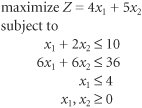
Solution
| Step 1. | Plot the Constraint Lines as Equations A simple method for plotting constraint lines is to set one of the constraint variables equal to zero and solve for the other variable to establish a point on one of the axes. The three constraint lines are graphed in the following figure: The constraint equations |
| Step 2. | Determine the Feasible Solution Area The feasible solution area is determined by identifying the space that jointly satisfies the  conditions of all three constraints, as shown in the following figure: conditions of all three constraints, as shown in the following figure: The feasible solution space and extreme points |
| Step 3. | Determine the Solution Points The solution at point A can be determined by noting that the constraint line intersects the x 2 axis at 5; thus, x 2 = 5, x 1 = 0, and Z = 25. The solution at point D on the other axis can be determined similarly; the constraint intersects the axis at x 1 = 4, x 2 = 0, and Z = 16. x 1 = 6 x 2 x 1 = 6 (4) x 1 = 2 Thus, at point B , x 1 = 2, x 2 = 4, and Z = 28. At point C , x 1 = 4. Substituting x 1 = 4 into the equation x 1 = 6 x 2 gives a value for x 2 : 4 = 6 x 2 x 2 = 2 Thus, x 1 = 4, x 2 = 2, and Z = 26. |
| Step 4. | Determine the Optimal Solution The optimal solution is at point B , where x 1 = 2, x 2 = 4, and Z = 28. The optimal solution and solutions at the other extreme points are summarized in the following figure: Optimal solution point |
EAN: 2147483647
Pages: 358


